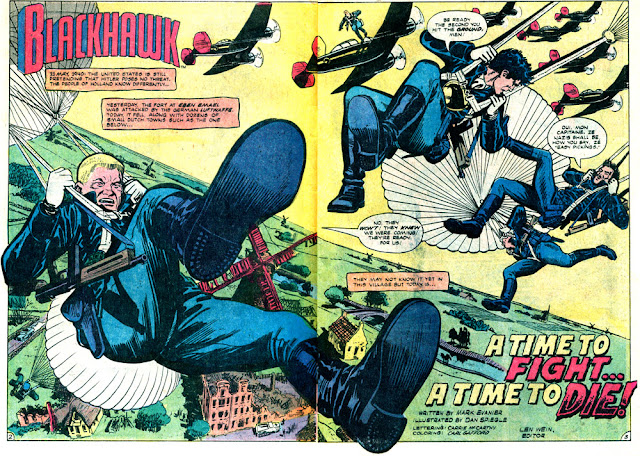I was completely unprepared for just how good this series would be. I've always been a fan of Howard Chaykin's late 1980s revival, but this one went under the radar. Evanier and Spiegle were in top form throughout this series. If DC is listening, this run is a prime candidate for collection.
 |
| From Blackhawk #251 (1982). Art by Dan Spiegle. |
"Our run on Blackhawk caused some tumult in the DC halls because most everyone had predicted a quick flop of a book that was only being revived for licensing reasons. It didn't sell well but it sold above all projections and garnered a lot of in-house fans. (The biggest problem was that DC couldn't sell reprint rights to their biggest overseas customer. For some reason, Germany didn't want a comic book that was all about killing Germans.)"Evanier and Spiegle had some history of working together prior to this. Though both were passionate about war comics, they had produced Scooby Doo... Mystery Comics before DC had it, at Gold Key. After Blackhawk, they moved on to Crossfire for Eclipse. Spiegle graduated from Los Angeles's Chouinard Art Institute and quickly found gig drawing the "Hopalong Cassidy" newspaper strip, then Maverick for Western in the 1950s. When Western became Gold Key, the publisher shifted to funny animal and Dan was put on Scooby. Evanier's career included a lot of TV writing, such as "Welcome Back, Kotter" and countless cartoons, even "Plastic Man."
Evanier frequently wrote in the letters columns about the decisions affecting the series, and the frequent changes in editors (Len Wein lasted one issue, then Marv Wolfman and Ernie Colon for a handful each, finally Evanier himself).
Even though this revival of Blackhawk did not begin with issue #1, it was created as a "clean slate," and was not intended to be in continuity with previous Blackhawk eras. They considered this version to be the Earth-One version of Blackhawk, a relatively blank slate though heavily based on the Quality Comics adventures. Evanier said in the letters column of issue #257, "The Blackhawks adventures in this comic are the first-ever exploits of the Blackhawks of Earth-1 and all previous Blackhawk stories took place on Earth-2 or Earth-X (which took place on which, I don't even want to begin to think about). The reason Marv [Wolfman] and I opted for Earth-1 is that, we felt if we chose any other, it would be difficult to do the book and still make it comprehensible to those who don't have the first 259 issues. I don't even have the first 249 issues, though I have a lot of them." He acknowledged that there was still a continuity problem with the (Earth-1) Justice League's appearance in Blackhawk #228 (Jan. 1967). He concluded by saying, "I think you'll find yourself enjoying a number of issues that couldn't have been done if we had to adhere to the constraints of the 'Mythos' of Earth-2 or Earth-X."
 |
| Evanier and Spiegle's Blackhawk: tough, handsome—and sensitive. From Blackhawk #269 (1984). |
The series opened in 1940, before the United States’ entrance into World War II. To set the tone, Evanier’s first pages introduced Hitler himself, and briefly described his rise to power. It read rather like a serial, with many plot threads continuing over many months, but not to the detriment of the individual installments.
 |
| The beautiful and deadly Domino, from Blackhawk #261 (1983). Art by Dan Spiegle. |
In #253, Mark Evanier described the members in more detail, saying he was attempting to cross-pollinate the older versions, mixing some of the crazy original Nazi machines and forgotten lands with modern characterization. Evanier himself had begun reading comics in 1962 and fell in love with DC's Blackhawk, but always felt their adventures were anachronistic. When he delved further back, into their earlier Quality appearances, he discovered he preferred those. Evanier and Spiegle's Blackhawks reported directly to Winston Churchill in London, and were volunteers. The location of their base, Blackhawk Island, was top secret. As in their earliest Quality Comics adventures, their planes in this series were the Grumman XF5F-1 Skyrockets.
» Read the full profile at Cosmic Teams!

If only Spielberg had made this instead of "1941." It could have completed the modernized serial hat trick of Indiana Jones and Star Wars! Really great scan of Domino, my favorite part of this revamp. I've only read a few of these issues over the years, but I bought a batch for a dime each not long back, and really ought to read 'em!
ReplyDelete